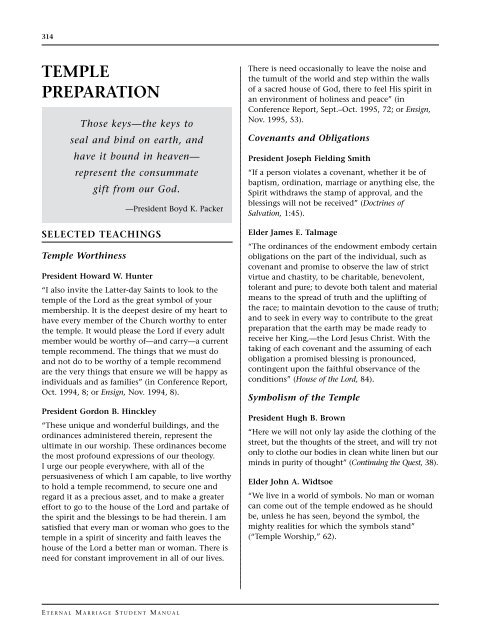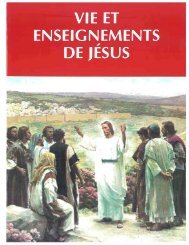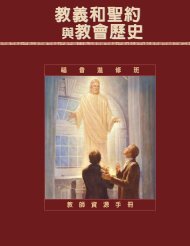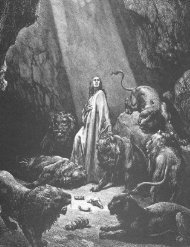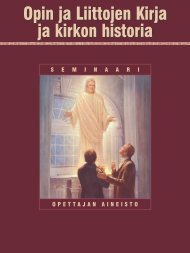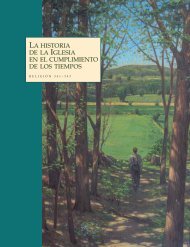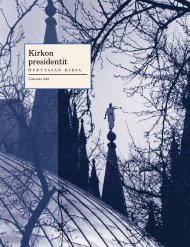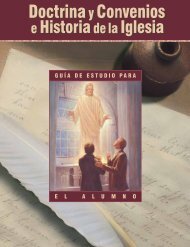Marriage : Temple Preparation
Marriage : Temple Preparation
Marriage : Temple Preparation
You also want an ePaper? Increase the reach of your titles
YUMPU automatically turns print PDFs into web optimized ePapers that Google loves.
314TEMPLEPREPARATIONThose keys—the keys toseal and bind on earth, andhave it bound in heaven—represent the consummateSELECTED TEACHINGS<strong>Temple</strong> Worthinessgift from our God.—President Boyd K. PackerPresident Howard W. Hunter“I also invite the Latter-day Saints to look to thetemple of the Lord as the great symbol of yourmembership. It is the deepest desire of my heart tohave every member of the Church worthy to enterthe temple. It would please the Lord if every adultmember would be worthy of—and carry—a currenttemple recommend. The things that we must doand not do to be worthy of a temple recommendare the very things that ensure we will be happy asindividuals and as families” (in Conference Report,Oct. 1994, 8; or Ensign, Nov. 1994, 8).President Gordon B. Hinckley“These unique and wonderful buildings, and theordinances administered therein, represent theultimate in our worship. These ordinances becomethe most profound expressions of our theology.I urge our people everywhere, with all of thepersuasiveness of which I am capable, to live worthyto hold a temple recommend, to secure one andregard it as a precious asset, and to make a greatereffort to go to the house of the Lord and partake ofthe spirit and the blessings to be had therein. I amsatisfied that every man or woman who goes to thetemple in a spirit of sincerity and faith leaves thehouse of the Lord a better man or woman. There isneed for constant improvement in all of our lives.There is need occasionally to leave the noise andthe tumult of the world and step within the wallsof a sacred house of God, there to feel His spirit inan environment of holiness and peace” (inConference Report, Sept.–Oct. 1995, 72; or Ensign,Nov. 1995, 53).Covenants and ObligationsPresident Joseph Fielding Smith“If a person violates a covenant, whether it be ofbaptism, ordination, marriage or anything else, theSpirit withdraws the stamp of approval, and theblessings will not be received” (Doctrines ofSalvation, 1:45).Elder James E. Talmage“The ordinances of the endowment embody certainobligations on the part of the individual, such ascovenant and promise to observe the law of strictvirtue and chastity, to be charitable, benevolent,tolerant and pure; to devote both talent and materialmeans to the spread of truth and the uplifting ofthe race; to maintain devotion to the cause of truth;and to seek in every way to contribute to the greatpreparation that the earth may be made ready toreceive her King,—the Lord Jesus Christ. With thetaking of each covenant and the assuming of eachobligation a promised blessing is pronounced,contingent upon the faithful observance of theconditions” (House of the Lord, 84).Symbolism of the <strong>Temple</strong>President Hugh B. Brown“Here we will not only lay aside the clothing of thestreet, but the thoughts of the street, and will try notonly to clothe our bodies in clean white linen but ourminds in purity of thought” (Continuing the Quest, 38).Elder John A. Widtsoe“We live in a world of symbols. No man or womancan come out of the temple endowed as he shouldbe, unless he has seen, beyond the symbol, themighty realities for which the symbols stand”(“<strong>Temple</strong> Worship,” 62).E TERNAL M ARRIAGE S TUDENT M ANUAL
T EMPLE P REPARATION315Purpose of the EndowmentThe Prophet Joseph Smith“You need an endowment, brethren, in order thatyou may be prepared and able to overcome allthings” (History of the Church, 2:309).President Brigham Young“Let me give you a definition in brief. Yourendowment is, to receive all those ordinances in thehouse of the Lord, which are necessary for you,after you have departed this life, to enable you towalk back to the presence of the Father, passing theangels who stand as sentinels, . . . and gain youreternal exaltation” (Discourses of Brigham Young, 416).President Joseph Fielding Smith“It is a wonderful thing to come into the Church, butyou cannot receive an exaltation until you have madecovenants in the house of the Lord and received thekeys and authorities that are there bestowed andwhich cannot be given in any other place on theearth today” (Doctrines of Salvation, 2:253).Elder John A. Widtsoe“The temple endowment relates the story of man’seternal journey; sets forth the conditions upon whichprogress in the eternal journey depends; requirescovenants or agreements of those participating, toaccept and use the laws of progress; gives tests bywhich our willingness and fitness for righteousnessmay be known, and finally points out the ultimatedestiny of those who love truth and live by it” (Programof the Church of Jesus Christ of Latter-day Saints, 178).Understanding the EndowmentElder John A. Widtsoe“The endowment which was given by revelationcan best be understood by revelation; and to thosewho seek most vigorously, with pure hearts, will therevelation be greatest” (“<strong>Temple</strong> Worship,” 63).Elder Harold B. Lee“When you enter a holy temple, you are by thatcourse gaining fellowship with the Saints in God’seternal kingdom, where time is no more. In thetemples of your God you are endowed not witha rich legacy of worldly treasure, but with a wealthof eternal riches that are above price.“The temple ceremonies are designed by a wiseHeavenly Father who has revealed them to us inthese last days as a guide and a protectionthroughout our lives, that you and I might not failto merit exaltation in the celestial kingdom whereGod and Christ dwell” (“Enter a Holy <strong>Temple</strong>,”Improvement Era, June 1967, 144).Elder Carlos E. Asay“A few years ago, in a seminar for new templepresidents and matrons, Elder James E. Faust, thenof the Quorum of the Twelve Apostles, told abouthis being called to serve as a General Authority. Hewas asked only one question by President Harold B.Lee: ‘Do you wear the garments properly?’ to whichhe answered in the affirmative. He then asked ifPresident Lee wasn’t going to ask him about hisworthiness. President Lee replied that he didn’tneed to, for he had learned from experience that howone wears the garment is the expression of how theindividual feels about the Church and everythingthat relates to it. It is a measure of one’s worthinessand devotion to the gospel.“There are some who would welcome a detaileddress code answering every conceivable questionabout the wearing of the temple garment. Theywould have priesthood leaders legislate lengths,specify conditions of when and how it should andshould not be worn, and impose penalties uponthose who missed the mark by a fraction of an inch.Such individuals would have Church membersstrain at a thread and omit the weightier mattersof the gospel of Jesus Christ (see Matt. 23:23–26).“Most Latter-day Saints, however, rejoice over themoral agency extended them by a loving Father inHeaven. They prize highly the trust placed in themby the Lord and Church leaders—a trust implied inthis statement made by the Prophet Joseph Smith:‘I teach them correct principles, and they governthemselves.’ [As quoted by John Taylor, MillennialStar, 15 Nov. 1851, 339.]” (“The <strong>Temple</strong> Garment:‘An Outward Expression of an InwardCommitment,’” Ensign, Aug. 1997, 19).E TERNAL M ARRIAGE S TUDENT M ANUAL
316T EMPLEP REPARATIONARRANGEMENTSFOR A TEMPLE MARRIAGELatter-day Saints are taught the importance ofbeing married in the temple. There, the marriageof a bride and groom is sealed for eternity.There are several details that must be attended tobefore you can be married in the temple. Somehave to do with the laws of the Church and somewith civil laws of the land. Since temples arelocated in many different countries, legalrequirements differ.If you are considering marriage in a certaintemple, you should contact that temple andrequest the necessary information. For templeaddresses, please ask your bishop. He shouldhave a copy of the “All <strong>Temple</strong> Schedule” for thecurrent year.Listed below are some of the arrangements youshould consider.Laws of the LandSerological TestsSome areas require you to get blood tests toobtain a marriage license.<strong>Marriage</strong> LicenseIf civil law recognizes a temple marriage, youwill need a marriage license valid in the civiljurisdiction in which the temple is located.In the United States and Canada you must take tothe temple a legal license that permits you tomarry. This license can be obtained in the countryor state/province in which the temple is located.In some locations you might have to establishresidency before a license can be granted.ConsentDepending on your age, you may need to haveyour parents with you to give written consent inorder to obtain a marriage license.Waiting PeriodSome governmental entities require a waitingperiod between the date you apply for yourlicense and the date that you may receive it.Civil Ceremony Preceding <strong>Temple</strong> Sealing<strong>Temple</strong> marriages in some countries arerecognized by the law of the land. Laws inmany other countries, however, require personsdesiring to be sealed in these temples to bemarried civilly first.Church ProceduresWitnessesTwo male members of the Church who havecurrent temple recommends will serve aswitnesses to your marriage. You may select yourown witnesses, who will sign your marriagepapers at the temple, or the temple will providewitnesses.<strong>Temple</strong> <strong>Marriage</strong> RecommendWhen going to the temple to receive yourendowment or to be sealed in marriage, youmust have two recommends: the templerecommend and the recommend for livingordinances. The first part you will use to returnto the temple to do work for the dead. The latterpart is the recommend for your endowment,marriage, or sealing. It includes informationfrom your membership record, such as yourparents’ names, your baptismal date, and yourendowment date if you have been endowedpreviously. It must also indicate that you havecome to the temple to be married.Announcements and InvitationsDo not mail announcements or invitations untilyour temple marriage recommend is obtained toavoid possible embarrassment if the recommend isdenied for any reason. Be aware that follow-upinterviews may be scheduled as you near the dateof your marriage.Less than a YearA person may not receive a temple recommenduntil one full year has passed following baptismand confirmation. If a couple is civilly marriedand then decides that they wish to be sealed inthe temple, they must wait one year from thedate of their civil marriage to be sealed. Thisrestriction applies only to those people whocould have been married in the temple initiallybut chose not to do so.E TERNAL M ARRIAGE S TUDENT M ANUAL
T EMPLE P REPARATION 317Time and DateCouples should coordinate their wedding planswith the temple to make certain it will be openon the day and at the time they have chosen.Your bishop will have a schedule.Endowment and SealingCouples who plan to be sealed must first receivetheir endowments. You can receive yourendowment on the day of the sealing or before.You should plan to spend three to four hours foryour own endowment. The sealing, including thecounsel given by the person who officiates, willtake another forty-five minutes. When you arebeing endowed or sealed, you should be at thetemple one hour before the session or sealing isscheduled.<strong>Temple</strong> ClothingSpecial white clothing is worn in the temple.You may rent it at the temple or take your ownwith you.Wedding DressesBrides may wear their wedding dresses in thetemple to be sealed. Dresses must be white,without heavy ornamentation, have long sleevesand a modest neckline, have all sheer materiallined, and the train must be removable or be ableto be pinned or hooked up out of the way. If thereis any question about appropriateness, take thedress or fabric and pattern to the temple forapproval. Brides may wear their wedding dressesduring the endowment session but must removethe trains for the session. They may not weargowns with long dress pants in the temple. Manytemples have beautiful white dresses for thosewho might need one for their special occasion.Check with individual temples for availability.Storage of Wedding DressWedding gowns may be delivered to mosttemples before the sealing. The gowns will betaken to a bride’s dressing room and held for you.Number of GuestsBecause the sealing rooms vary in size, youshould inform the temple (when you makereservations) how many guests you expect toattend your sealing. Only persons who havereceived their own endowment and have currenttemple recommends may attend the sealing. Mosttemples are not able to accommodate largegroups. Therefore, invitations should be limitedto family members and close friends.Inform Guests of Time and ClothingRequirementsIf you are receiving your endowment on yourwedding day, you may want some guests toparticipate in an endowment session with you.Other guests may have time only to attend yoursealing. In either case, you must inform theseguests when they should arrive at the temple.Double-check this information with the temple.Guests should be counseled to dress as theywould to attend a sacrament meeting. Tuxedosor other formal wear is not appropriate. Allguests must have current temple recommends.OfficiatorThe temple presidency and other temple sealersare officially set apart to perform templemarriages. Because the General Authorities haveheavy schedules, the Church members have beenasked not to request them to perform marriages.LanguageMost temples have sessions in multiplelanguages. Check with the temple president toverify that your endowment and marriage willbe in the language of your choice.Taking Pictures on <strong>Temple</strong> GroundsCameras are not permitted inside the temple.After the sealing, pictures of the bride andgroom can be taken on the temple grounds.Therefore, your photographer is not requiredto have a temple recommend.Other InformationEach temple will supply you or your bishopwith all the necessary information to plan yourtemple marriage. You can always telephone thetemple (ask for the marriage clerk) or write tothe temple president if you have questions.E TERNAL M ARRIAGE S TUDENT M ANUAL
318T EMPLEP REPARATIONSummary ChecklistMark when completed:❏ Contact temple to be married in and requestnecessary information. Date __________❏ Reserve date and time for your marriage withthe temple. Date __________ Time _____❏ Make sure the number of invited guests isnot larger than the reserved temple room.❏ Indicate in your temple reservation thelanguage you wish the ceremony to beconducted in.❏ Inform invited guests of the temple’sclothing requirements.❏ If not already endowed, reserve a date andtime for own endowment. Date __________Time _____❏ Invite those you wish to accompany you tobe endowed, and inform them of the dateand time.❏ Obtain blood tests, if necessary.❏ Date __________ N/A _____❏ <strong>Marriage</strong> license❏ Residency required? Yes ___ No ___❏ Consent required? Yes ___ No ___❏ Waiting period required? Yes ___ No ___❏ Civil ceremony required to precede templesealing? Yes ___ No ___ If yes, date, time, bywhom? ____________________ Arranged _____❏ Arrange for witnesses for the temple ceremony.❏ Have temple recommend with recommend forendowment and/or marriage. Date __________❏ If married civilly, by our own choice, we havewaited one year. N/A _____❏ <strong>Temple</strong> garments. If not previously endowed,we have talked with our bishops about thepurpose of garments. Date __________Garments purchased _____❏ Wedding dress: white __ long sleeves __modest high neckline __ sheer materialslined __❏ If desired, I will rent a white dress at thetemple. Checked with temple for availability.N/A _____THE HOLY TEMPLEPresident Boyd K. PackerActing Presidentof the Quorumof the Twelve ApostlesEnsign, Feb. 1995,32–36There are many reasons one should want to cometo the temple. Even its external appearance seemsto hint of its deeply spiritual purposes. This is muchmore evident within its walls. Over the door to thetemple appears the tribute. “Holiness to the Lord.”When you enter any dedicated temple, you are inthe house of the Lord.In the temples, members of the Church who makethemselves eligible can participate in the mostexalted of the redeeming ordinances that have beenrevealed to mankind. There, in a sacred ceremony,an individual may be washed and anointed andinstructed and endowed and sealed. And when wehave received these blessings for ourselves, we mayofficiate for those who have died without havinghad the same opportunity. In the temples sacredordinances are performed for the living and for thedead alike.These Things Are SacredA careful reading of the scriptures reveals that theLord did not tell all things to all people. There weresome qualifications set that were prerequisite toreceiving sacred information. <strong>Temple</strong> ceremoniesfall within this category.We do not discuss the temple ordinances outside thetemples. It was never intended that knowledge ofthese temple ceremonies would be limited to a selectfew who would be obliged to ensure that othersnever learn of them. It is quite the opposite, in fact.With great effort we urge every soul to qualify andprepare for the temple experience. Those who havebeen to the temple have been taught an ideal:Someday every living soul and every soul who hasever lived shall have the opportunity to hear thegospel and to accept or reject what the templeoffers. If this opportunity is rejected, the rejectionmust be on the part of the individual himself.The ordinances and ceremonies of the temple aresimple. They are beautiful. They are sacred. TheyE TERNAL M ARRIAGE S TUDENT M ANUAL
T EMPLE P REPARATION 319are kept confidential lest they be given to thosewho are unprepared. Curiosity is not a preparation.Deep interest itself is not a preparation. <strong>Preparation</strong>for the ordinances includes preliminary steps: faith,repentance, baptism, confirmation, worthiness, amaturity and dignity worthy of one who comesinvited as a guest into the house of the Lord.All who are worthy and qualify in every way mayenter the temple, there to be introduced to thesacred rites and ordinances.Worthy to EnterOnce you have some feeling for the value of templeblessings and for the sacredness of the ordinancesperformed in the temple, you would be hesitant toquestion the high standards set by the Lord forentrance into the holy temple.You must possess a current recommendto be admitted to the temple. Thisrecommend must be signed by theproper officers of the Church. Onlythose who are worthy should go to thetemple. Your local bishop or branchpresident has the responsibility ofmaking inquiries into your personal worthiness.This interview is of great importance, for it is anoccasion to explore with an ordained servant of theLord the pattern of your life. If anything is amiss inyour life, the bishop will be able to help you resolveit. Through this procedure, as you counsel with thecommon judge in Israel, you can declare or can behelped to establish your worthiness to enter thetemple with the Lord’s approval.The interview for a temple recommend is conductedprivately between the bishop and the Church memberconcerned. Here the member is asked searchingquestions about his personal conduct and worthinessand about his loyalty to the Church and its officers.The person must certify that he is morally clean andis keeping the Word of Wisdom, paying a full tithe,living in harmony with the teachings of the Church,and not maintaining any affiliation or sympathywith apostate groups. The bishop is instructed thatconfidentiality in handling these matters with eachinterviewee is of the utmost importance.Acceptable answers to the bishop’s questions willordinarily establish the worthiness of an individualto receive a temple recommend. If an applicant is notkeeping the commandments or there is somethingThe temple is agreat school. It is ahouse of learning.unsettled about his life that needs putting in order,it will be necessary for him to demonstrate truerepentance before a temple recommend is issued.After the bishop has conducted such an interview,a member of the stake presidency likewise interviewseach of us before we go to the temple.Taught from on HighBefore going to the temple for the first time, or evenafter many times, it may help you to realize thatthe teaching in the temples is done in symbolicfashion. The Lord, the Master Teacher, gave muchof His instruction in this way.The temple is a great school. It is a house of learning.In the temples the atmosphere is maintained so thatit is ideal for instruction on matters that are deeplyspiritual. The late Elder John A. Widtsoe of theQuorum of the Twelve was adistinguished university president and aworld renowned scholar. He had greatreverence for temple work and said onone occasion:“The temple ordinances encompassthe whole plan of salvation, as taughtfrom time to time by the leaders of the Church, andelucidate matters difficult of understanding. There isno warping or twisting in fitting the templeteachings into the great scheme of salvation. Thephilosophical completeness of the endowment isone of the great arguments for the veracity of thetemple ordinances. Moreover, this completeness ofsurvey and expounding of the Gospel plan, makestemple worship one of the most effective methods inrefreshing the memory concerning the wholestructure of the Gospel” (Utah Genealogical andHistorical Magazine, Apr. 1921, p. 58).If you will go to the temple and remember that theteaching is symbolic, you will never go in the properspirit without coming away with your visionextended, feeling a little more exalted, with yourknowledge increased as to things that are spiritual.The teaching plan is superb. It is inspired. The LordHimself, the Master Teacher, taught His disciplesconstantly in parables—a verbal way to representsymbolically things that might otherwise bedifficult to understand.E TERNAL M ARRIAGE S TUDENT M ANUAL
320T EMPLEP REPARATIONThe temple itself becomes a symbol. If you haveseen one of the temples at night, fully lighted, youknow what an impressive sight that can be. Thehouse of the Lord, bathed in light, standing out inthe darkness, becomes symbolic of the power andthe inspiration of the gospel of Jesus Christstanding as a beacon in a world that sinks everfurther into spiritual darkness.Upon entering the temple you exchange your streetclothing for the white clothing of the temple. Thischange of clothing takes place in the locker room,where each individual is provided with a locker anddressing space that is completely private. In thetemple the ideal of modesty is carefully maintained.As you put your clothing in the locker you leaveyour cares and concerns and distractions there withthem. You step out of this private little dressing areadressed in white and you feel a oneness and a senseof equality, for all around you are similarly dressed.The Power to SealFor those of you who look forward to a templemarriage, you may want to know what will occur.We do not quote the words of the sealing (marriage)ordinance outside of the temple, but we maydescribe the sealing room as being beautiful in itsappointment, quiet and serene in spirit, andhallowed by the sacred work that is performed there.Before the couple comes to the altar for the sealingordinance it is the privilege of the officiator toextend, and of the young couple to receive, somecounsel. These are among the thoughts thata young couple might hear on this occasion.“Today is your wedding day. You are caught up inthe emotion of your marriage. <strong>Temple</strong>s were built asa sanctuary for such ordinances as this. We are notin the world. The things of the world do not applyhere and should have no influence upon what wedo here. We have come out of the world into thetemple of the Lord. This becomes the most importantday of your lives.“You were born, invited to earth, by parents whoprepared a mortal tabernacle for your spirit toinhabit. Each of you has been baptized. Baptism,a sacred ordinance, is symbolic of a cleansing,symbolic of death and resurrection, symbolic ofcoming forward in a newness of life. It contemplatesrepentance and a remission of sins. The sacramentof the Lord’s Supper is a renewal of the covenantof baptism, and we can, if we live for it, retain aremission of our sins.“You, the groom, were ordained to the priesthood.You had first conferred upon you the AaronicPriesthood and probably have progressed throughall the offices thereof—deacon, teacher, and priest.Then the day came when you were found worthy toreceive the Melchizedek Priesthood. That priesthood,the higher priesthood, is defined as the priesthoodafter the holiest order of God, or the Holy Priesthoodafter the Order of the Son of God (see Alma 13:18;Hel. 8:18; D&C 107:2–4). You were given an officein the priesthood. You are now an elder.“Each of you has received your endowment. In thatendowment you received an investment of eternalpotential. But all of these things, in one sense, werepreliminary and preparatory to your coming to thealtar to be sealed as husband and wife for time andfor all eternity. You now become a family, free toact in the creation of life, to have the opportunitythrough devotion and sacrifice to bring childreninto the world and to raise them and foster themsafely through their mortal existence; to see themcome one day, as you have come, to participate inthese sacred temple ordinances.“You come willingly and have been judged to beworthy. To accept one another in the marriagecovenant is a great responsibility, one that carrieswith it blessings without measure.”If we would understand both the history and thedoctrine of temple work, we must understand whatthe sealing power is. We must envision, at least toa degree, why the keys of authority to employ thesealing power are crucial—crucial not just to theordinance work of the temples but to all ordinancework in all the Church throughout the world.The sealing power represents the transcendentdelegation of spiritual authority from God to man.The keeper of that sealing power is the Lord’s chiefrepresentative here upon the earth, the President ofthe Church. That is the position of consummatetrust and authority.As has been said, much of the teaching relating tothe deeper spiritual things in the Church, particularlyin the temple, is symbolic. We use the word keys ina symbolic way. Here the keys of priesthoodauthority represent the limits of the power extendedE TERNAL M ARRIAGE S TUDENT M ANUAL
T EMPLE P REPARATION 321from beyond the veil to mortal man to act in thename of God upon the earth. The words seal andkeys and priesthood are closely linked together.The keys of the sealing power are synonymous withthe keys of the everlasting priesthood. “When Jesuscame into the coasts of Caesarea Philippi, he askedhis disciples, saying, Whom do men say that I theSon of man am? . . .“And Simon Peter answered and said, Thou art theChrist, the Son of the living God.“And Jesus answered and said unto him, Blessed artthou, Simon Bar-jona: for flesh and blood hath notrevealed it unto thee, but my Father which is inheaven.“And I say also unto thee, That thou art Peter, andupon this rock I will build my church; and the gatesof hell shall not prevail against it.“And I will give unto thee the keys of the kingdomof heaven: and whatsoever thou shalt bind on earthshall be bound in heaven: and whatsoever thoushalt loose on earth shall be loosed in heaven”(Matt. 16:13–19).Peter was to hold the keys. Peter was to hold thesealing power, that authority which carried thepower to bind or seal on earth or to loose on earthand it would be so in the heavens. Those keys belongto the President of the Church—to the prophet, seer,and revelator. That sacred sealing power is with theChurch now. Nothing is regarded with more sacredcontemplation by those who know the significanceof this authority. Nothing is more closely held. Thereare relatively few men who have been delegatedthis sealing power upon the earth at any giventime—in each temple are brethren who have beengiven the sealing power. No one can get it exceptfrom the prophet, seer, and revelator and Presidentof The Church of Jesus Christ of Latter-day Saints.A clear statement follows regarding the sealing poweras binding on all that we do for the living and thedead.“Whenever the fulness of the gospel is on earth, theLord has agents to whom he gives power to bind onearth and seal eternally in the heavens (Matt. 16:19;18:18; Hel. 10:3–10; D&C 132:46–49.) . . .“All things that are not sealed by this power havean end when men are dead. Unless a baptism hasthis enduring seal, it will not admit a person to thecelestial kingdom; unless an eternal marriagecovenant is sealed by this authority, it will not takethe participating parties to an exaltation in thehighest heaven within the celestial world.“All things gain enduring force and validity becauseof the sealing power. So comprehensive is this powerthat it embraces ordinances performed for the livingand the dead, seals the children on earth up to theirfathers who went before, and forms the enduringpatriarchal chain that will exist eternally amongexalted beings” (Bruce R. McConkie, Mormon Doctrine,2d ed., Salt Lake City: Bookcraft, 1966, p. 683).In the Church we hold sufficient authority to performall of the ordinances necessary to redeem and toexalt the whole human family. And, because wehave the keys to the sealing power, what we bind inproper order here will be bound in heaven. Thosekeys—the keys to seal and bind on earth, and haveit bound in heaven—represent the consummate giftfrom our God. With that authority we can baptizeand bless, we can endow and seal, and the Lord willhonor our commitments.The Prophet Joseph Smith said he was frequentlyasked the question, “‘Can we not be saved withoutgoing through with all those ordinances, etc?’ I wouldanswer, No, not the fullness of salvation. Jesus said,‘There are many mansions in my Father’s house,and I will go and prepare a place for you.’ House herenamed should have been translated kingdom; andany person who is exalted to the highest mansionhas to abide a celestial law, and the whole law too”(History of the Church, 6:184).Not without Opposition<strong>Temple</strong>s are the very center of the spiritual strengthof the Church. We should expect that the adversarywill try to interfere with us as a church and with usindividually as we seek to participate in this sacredand inspired work. <strong>Temple</strong> work brings so muchresistance because it is the source of so muchspiritual power to the Latter-day Saints and to theentire Church.At the Logan <strong>Temple</strong> cornerstone dedication,President George Q. Cannon made this statement:“Every foundation stone that is laid for a <strong>Temple</strong>,and every <strong>Temple</strong> completed according to the orderthe Lord has revealed for his holy Priesthood, lessensthe power of Satan on the earth, and increases theE TERNAL M ARRIAGE S TUDENT M ANUAL
322T EMPLEP REPARATIONpower of God and Godliness, moves the heavens inmighty power in our behalf, invokes and calls downupon us the blessings of the Eternal Gods, and thosewho reside in their presence” (Millennial Star,12 Nov. 1877, p. 743).When members of the Church are troubled or whencrucial decisions weigh heavily upon their minds, itis a common thing for them to go to the temple. It isa good place to take our cares. In the temple we canreceive spiritual perspective. There, during the timeof the temple service, we are “out of the world.”Sometimes our minds are so beset with problems,and there are so many things clamoring for attentionat once that we just cannot think clearly and seeclearly. At the temple the dust of distraction seemsto settle out, the fog and the haze seem to lift, andwe can “see” things that we were not able to seebefore and find a way through our troubles that wehad not previously known.The Lord will bless us as we attend tothe sacred ordinance work of thetemples. Blessings there will not belimited to our temple service. We willbe blessed in all of our affairs.Come to the <strong>Temple</strong>No work is more of a protection to this church thantemple work and the genealogical research thatsupports it. No work is more spiritually refining.No work we do gives us more power. No workrequires a higher standard of righteousness.Our labors in the temple cover us with a shield anda protection, both individually and as a people.So come to the temple—come and claim yourblessings. It is a sacred work.The Lord will blessus as we attend tothe sacredordinance work ofthe temples.THE TEMPLE GARMENT: “ANOUTWARD EXPRESSION OF ANINWARD COMMITMENT”Elder Carlos E. AsayEmeritus Memberof the First Quorumof the SeventyEnsign, Aug. 1997,18–23A few years ago, in a seminar for new templepresidents and matrons, Elder James E. Faust, thenof the Quorum of the Twelve Apostles, told abouthis being called to serve as a General Authority. Hewas asked only one question by President Harold B.Lee: “Do you wear the garmentsproperly?” to which he answered inthe affirmative. He then asked ifPresident Lee wasn’t going to ask himabout his worthiness. President Leereplied that he didn’t need to, for hehad learned from experience that howone wears the garment is theexpression of how the individual feelsabout the Church and everything thatrelates to it. It is a measure of one’s worthiness anddevotion to the gospel.There are some who would welcome a detailed dresscode answering every conceivable question aboutthe wearing of the temple garment. They wouldhave priesthood leaders legislate lengths, specifyconditions of when and how it should and shouldnot be worn, and impose penalties upon those whomissed the mark by a fraction of an inch. Suchindividuals would have Church members strain at athread and omit the weightier matters of the gospelof Jesus Christ (see Matt. 23:23–26).Most Latter-day Saints, however, rejoice over themoral agency extended them by a loving Father inHeaven. They prize highly the trust placed in themby the Lord and Church leaders—a trust implied inthis statement made by the Prophet Joseph Smith:“I teach them correct principles, and they governthemselves.” 1Samuel the Lamanite declared:E TERNAL M ARRIAGE S TUDENT M ANUAL
T EMPLE P REPARATION 323“And now remember, remember, my brethren, thatwhosoever perisheth, perisheth unto himself; andwhosoever doeth iniquity, doeth it unto himself;for behold, ye are free; ye are permitted to act foryourselves; for behold, God hath given unto you aknowledge and he hath made you free.“He hath given unto you that ye might know goodfrom evil, and he hath given unto you that ye mightchoose life or death; and ye can do good and berestored unto that which is good, or have that whichis good restored unto you; or ye can do evil, and havethat which is evil restored unto you” (Hel. 14:30–31).I believe there is a critical body of knowledge relatingto the temple garment. When that knowledge isobtained, Latter-day Saints filled with faith wear thegarment and wear it properly, not because someoneis policing their actions but because they understandthe virtues of the sacred clothing and want to “dogood and be restored unto that which is good.” Onthe other hand, when one does not understand thesacred nature of the temple garment, the tendencyis to treat it casually and regard it as just anotherpiece of cloth.The critical body of knowledge associated with thegarment of the holy priesthood may be categorizedunder three headings: Armor of God, HistoricalBackground, and Teachings of Modern Prophets.I shall present some information pertaining to eachof these headings, hoping that the thoughts sharedwill provoke a greater appreciation of the garmentand stir a greater resolve in the minds of Saints towear it willfully and properly.Armor of GodWe are at war! Our enemy is not an invading armyfrom a bordering nation or a navy of some overseaspower. Bullets are not whizzing above our heads,nor are bombs exploding in and around our homes.Nevertheless, we are engaged in a life-and-deathstruggle with forces capable of thrashing us insideout and sending us down into the depths of spiritualdefeat if we are not vigilant.I refer, of course, to the “wrestle” againstprincipalities, powers, rulers of darkness, andspiritual wickedness in high places spoken of by theApostle Paul (see Eph. 6:12). I refer to the onslaughtof immorality, crime, substance abuse, and otherinsidious influences threatening our society. Suchthreatening influences, along with other imminentdangers, constitute “the wiles of the devil” (Eph.6:11) against which we must stand in these“perilous times” (2 Tim. 3:1).Paul counseled: “Wherefore take unto you the wholearmour of God, that ye may be able to withstand inthe evil day, and having done all, to stand” (Eph.6:13). With his prophetic powers, Paul could foreseethe wicked conditions that would exist on the earthin our modern day. Therefore, he urged all Saints tohave their “loins girt about with truth” (Eph. 6:14),to put on “the breastplate of righteousness” (v. 14),to have their feet shod “with the preparation of thegospel of peace” (v. 15), to grasp “the shield of faith”(v. 16), to place on their heads “the helmet ofsalvation” (v. 17), to take “the sword of the Spirit,which is the word of God” (v. 17), and to prayalways (see v. 18) so that they might be preserved.He knew that armor made of truth, righteousness,faith, spirit, and prayer would protect people fromthe “fiery darts” (v. 16) crafted and thrown by Satanand his henchmen.There is, however, another piece of armor worthyof our consideration. It is the special underclothingknown as the temple garment, or garment of theholy priesthood, worn by members of The Churchof Jesus Christ of Latter-day Saints who have receivedtheir temple endowment. This garment, worn dayand night, serves three important purposes: it isa reminder of the sacred covenants made with theLord in His holy house, a protective covering forthe body, and a symbol of the modesty of dress andliving that should characterize the lives of all thehumble followers of Christ.It is written that “the white garment symbolizespurity and helps assure modesty, respect for theattributes of God, and, to the degree it is honored,a token of what Paul regarded as taking upon one thewhole armor of God (Eph. 6:13; cf. D&C 27:15). . . .Garments bear several simple marks of orientationtoward the gospel principles of obedience, truth,life, and discipleship in Christ.” 2Much, much more could be said about the war forthe souls of men and the whole armor of God.The war on the earth began in the days of Adam,continued down through the years with Moses andthe children of Israel, and still rages in a dispensationknown as the fulness of times—a dispensationushered in by the revelations received through theProphet Joseph Smith. Hence, the issue of protectivecoverings enabling us to withstand the fiery darts ofSatan will continue to be of great significance.E TERNAL M ARRIAGE S TUDENT M ANUAL
324T EMPLEP REPARATIONWe must put on the armor of God spoken of by theApostle Paul and reiterated in a modern revelation(see D&C 27:15–18). We must also “put on the armorof righteousness” (2 Ne. 1:23) symbolized by thetemple garment. Otherwise, we may lose the warand perish.The heavy armor worn by soldiers of a formerday, including helmets, shields, and breastplates,determined the outcome of some battles. However,the real battles of life in our modern day will bewon by those who are clad in a spiritual armor—anarmor consisting of faith in God, faith in self, faithin one’s cause, and faith in one’s leaders. The piece ofarmor called the temple garment not only providesthe comfort and warmth of a cloth covering, it alsostrengthens the wearer to resist temptation, fend offevil influences, and stand firmly for the right.Historical BackgroundIt should be understood that “the things of theLord” (2 Ne. 4:16) have included sacred clothingfrom the very beginning of this world. The scripturescontain many references to the wearing of specialgarments by the ancients. Prior to their expulsionfrom the Garden of Eden, Adam and Eve were cladin sacred clothing. We read: “Unto Adam also andto his wife did the Lord God make coats of skins,and clothed them” (Gen. 3:21).They received this clothing in a context ofinstruction on the Atonement, sacrifice, repentance,and forgiveness (see Moses 5:5–8). The templegarment given to Latter-day Saints is provided in asimilar context. It is given to remind wearers of thecontinuing need for repentance, the need to honorbinding covenants made in the house of the Lord,and the need to cherish and share virtue in our dailyliving so that promised blessings may be claimed.Moses was commanded to place holy garments andpriestly vestments upon Aaron and others, thuspreparing them to officiate in the tabernacle. Saidthe Lord to Moses, “And take thou unto thee Aaronthy brother, and his sons with him, from amongthe children of Israel . . . and thou shalt make holygarments for Aaron thy brother for glory and forbeauty . . . that he may minister unto me in thepriest’s office” (Ex. 28:1–3).References to Aaron’s clothing and the vestmentsof the priesthood worn by selected leaders in OldTestament times are accompanied by expressionssuch as “precious garments,” “glorious garments,”“garments of honor,” “coats of glory,” and “garmentsof salvation.” 3 These expressions may apply moreparticularly to the raiment worn by those whoofficiated in tabernacle or temple rites; nevertheless,these descriptive words also apply to the sacredclothing worn on a daily basis by those “who callthemselves by [God’s] name and are essaying to[become] saints” (D&C 125:2). The honor, glory,and precious nature of sacred garments, whetherworn only in the temple or in everyday life understreet clothes, transcends the material of which theyare made. Their full worth and beauty is appreciatedand regarded as precious or glorious when viewedthrough the “eye of faith” (Alma 5:15).“The garment is inadequate without the thing thatit signifies. . . . It won’t protect you unless you’retrue and faithful to your covenant, and only to thedegree to which you don’t dishonor your garmenthas it any significance at all. Only on that conditionthat you don’t dishonor it, that you’re pure, thatyou are true and faithful to your covenant—doesthe garment have any benefit,” wrote Hugh Nibley,an emeritus professor of ancient scripture atBrigham Young University. 4Yes, garments have been worn by prophets andother righteous Saints throughout the ages, wheneverthe ordinances of the priesthood and the templehave been available to the children of men. Whenthe Church was restored to the earth in our day, thesacred priesthood ordinances associated with theholy temple were revealed anew to the ProphetJoseph Smith. The revelations he received includedinstructions about the garment.Many references are found in the scriptures relatingto garments and clothing. Enoch declared: “I beheldthe heavens open, and I was clothed with glory”(Moses 7:3). Jacob spoke of a day of judgment when“we shall have a perfect knowledge of all our guilt,and our uncleanness, and our nakedness; and therighteous shall have a perfect knowledge of theirenjoyment, and their righteousness, being clothedwith purity, yea, even with the robe of righteousness”(2 Ne. 9:14). Isaiah rejoiced, saying, “God . . . hathclothed me with the garments of salvation, he hathcovered me with the robe of righteousness” (Isa.61:10). Alma referred to “all the holy prophets, whosegarments are cleansed and are spotless, pure andwhite” (Alma 5:24). These and other propheticstatements suggest not only a cleanliness and puritywithin one’s soul, but also a spotless covering overE TERNAL M ARRIAGE S TUDENT M ANUAL
T EMPLE P REPARATION 325one’s soul, signifying a life of goodness anddevotion to God.Teachings of Modern ProphetsI fear that too many Church members take forgranted the promise of protection and blessingsassociated with the temple garment. Some wear itimproperly, and others remove it to suit whims ofcircumstance. In such cases, the instructions ofmodern prophets, seers, and revelators are ignoredand spiritual protection placed in jeopardy.In a letter from the First Presidency dated 3 July1974, Church members were reminded of the sacrednature of the garment: “The sacredness of thegarment should be ever present and uppermost inthe wearer’s mind; . . . the blessings which flowfrom the observance of our covenants are sufficientlygreat to recompense for any mere inconvenience.To break our covenants is to forfeit the protectionand blessings promised for obedience to them.” 5And in a letter to priesthood leaders dated10 October 1988, the First Presidency made thefollowing important statements regarding how thegarment should be worn: “Church members whohave been clothed with the garment in the templehave made a covenant to wear it throughout theirlives. This has been interpreted to mean that it isworn as underclothing both day and night. Thissacred covenant is between the member and theLord. Members should seek the guidance of theHoly Spirit to answer for themselves any personalquestions about the wearing of the garment. . . .The promise of protection and blessings isconditioned upon worthiness and faithfulness inkeeping the covenant.“The fundamental principle ought to be to wear thegarment and not to find occasions to remove it.Thus, members should not remove either all or partof the garment to work in the yard or to loungearound the home in swimwear or immodest clothing.Nor should they remove it to participate in recreationalactivities that can reasonably be done withthe garment worn properly beneath regular clothing.When the garment must be removed, such as forswimming, it should be restored as soon as possible.“The principles of modesty and keeping the bodyappropriately covered are implicit in the covenantand should govern the nature of all clothing worn.Endowed members of the Church wear the garmentas a reminder of the sacred covenants they havemade with the Lord and also as a protection againsttemptation and evil. How it is worn is an outwardexpression of an inward commitment to followthe Savior.” 6President Joseph F. Smith had strong feelings aboutthe proper wearing of the garment. Said he: “The Lordhas given unto us garments of the holy priesthood,and you know what that means. And yet there arethose of us who mutilate them, in order that we mayfollow the foolish, vain and (permit me to say)indecent practices of the world. In order that suchpersons may imitate the fashions, they will nothesitate to mutilate that which should be held bythem the most sacred of all things in the world, nextto their own virtue, next to their own purity of life.They should hold these things that God has givenunto them sacred, unchanged and unaltered from thevery pattern in which God gave them. Let us havethe moral courage to stand against the opinions offashion, and especially where fashion compels us tobreak a covenant and so commit a grievous sin.” 7In his book, The Holy <strong>Temple</strong>, Elder Boyd K. Packerof the Quorum of the Twelve Apostles explainedsuccinctly why it is so important to wear thegarment properly.“The garment represents sacred covenants. It fostersmodesty and becomes a shield and protection tothe wearer.“The wearing of such a garment does not preventmembers from dressing in the fashionable clothinggenerally worn in nations of the world. Onlyclothing that is immodest or extreme in style wouldbe incompatible with wearing the garment.” 8What more needs to be said about the garment andthe way it is to be worn and treated? The principlesare stated clearly, and it is left to the wearers andtheir consciences to live accordingly. People of faithneed not be commanded in all things for they donot endeavor to excuse themselves in the least pointor over the absence of a Mosaic code of conduct.But rather, they govern their dress and behavior asGod and his prophets have decreed, allowing thejustice, mercy, and long-suffering of God to havefull sway in their hearts (see Alma 42:29–31).A Reminder We CarryI like to think of the garment as the Lord’s way ofletting us take part of the temple with us when weE TERNAL M ARRIAGE S TUDENT M ANUAL
326T EMPLEP REPARATIONleave. It is true that we carry from the Lord’s houseinspired teachings and sacred covenants written inour minds and hearts. However, the one tangibleremembrance we carry with us back into the worldis the garment. And though we cannot always be inthe temple, a part of it can always be with us tobless our lives.Don’t forget that the word garment is used symbolicallyin the scriptures and gives expanded meaningto other words such as white, clean, pure, righteous,modesty, covering, ceremonial, holy, priesthood, beautiful,perfection, salvation, undefiled, worthy, white raiment,shield, protection, spotless, blameless, armor, covenants,promises, blessings, respect, eternal life, and so forth. Allof these words occupy special places in the vocabulariesof people sincerely essaying to become Saints.Of one choice group of believers, it is written,“Thou hast a few names even in Sardis which havenot defiled their garments; and they shall walk withme in white: for they are worthy.“He that overcometh, the same shall be clothed inwhite raiment; and I will not blot out his name outof the book of life, but I will confess his name beforemy Father, and before his angels” (Rev. 3:4–5).How wonderful it would be if all Church memberswalked with God in white and were numbered withthe Saints in Sardis!Remember always that our very salvation depends,symbolically, upon the condition of our garments.The prophet Alma told the members of the Churchin his day that they could not be saved unless theirgarments were symbolically washed, cleansed, andmade white through the blood of Jesus Christ. Hetaught:“No man [can] be saved except his garments arewashed white; yea, his garments must be purifieduntil they are cleansed from all stain, through theblood of him of whom it has been spoken by ourfathers, who should come to redeem his peoplefrom their sins. . . .“Have ye walked, keeping yourselves blamelessbefore God? Could ye say, if ye were called to die atthis time, within yourselves, that ye have beensufficiently humble? That your garments have beencleansed and made white through the blood ofChrist, who will come to redeem his people fromtheir sins?” (Alma 5:21, 27).It is my prayer that our garments will be cleansedthrough the blood of Christ and that we willreaffirm in our minds and hearts the declaration“Zion must increase in beauty, and in holiness, . . .and put on her beautiful garments” (D&C 82:14).Notes1. As quoted by John Taylor, Millennial Star,15 Nov. 1851, 339.2. Evelyn T. Marshall, “Garments,” in Encyclopedia ofMormonism, ed. Daniel H. Ludlow, 5 vols. (1992),2:534; emphasis added.3. Encyclopedia of Mormonism, 2:534.4. “Sacred Vestments: A Preliminary Report,”Foundation for Ancient Research and MormonStudies (1986), 13.5. First Presidency Letter, 3 July 1974.6. First Presidency Letter, 10 Oct. 1988; emphasisadded.7. Improvement Era, Aug. 1906, 813.8. The Holy <strong>Temple</strong> (1980), 75.E TERNAL M ARRIAGE S TUDENT M ANUAL


